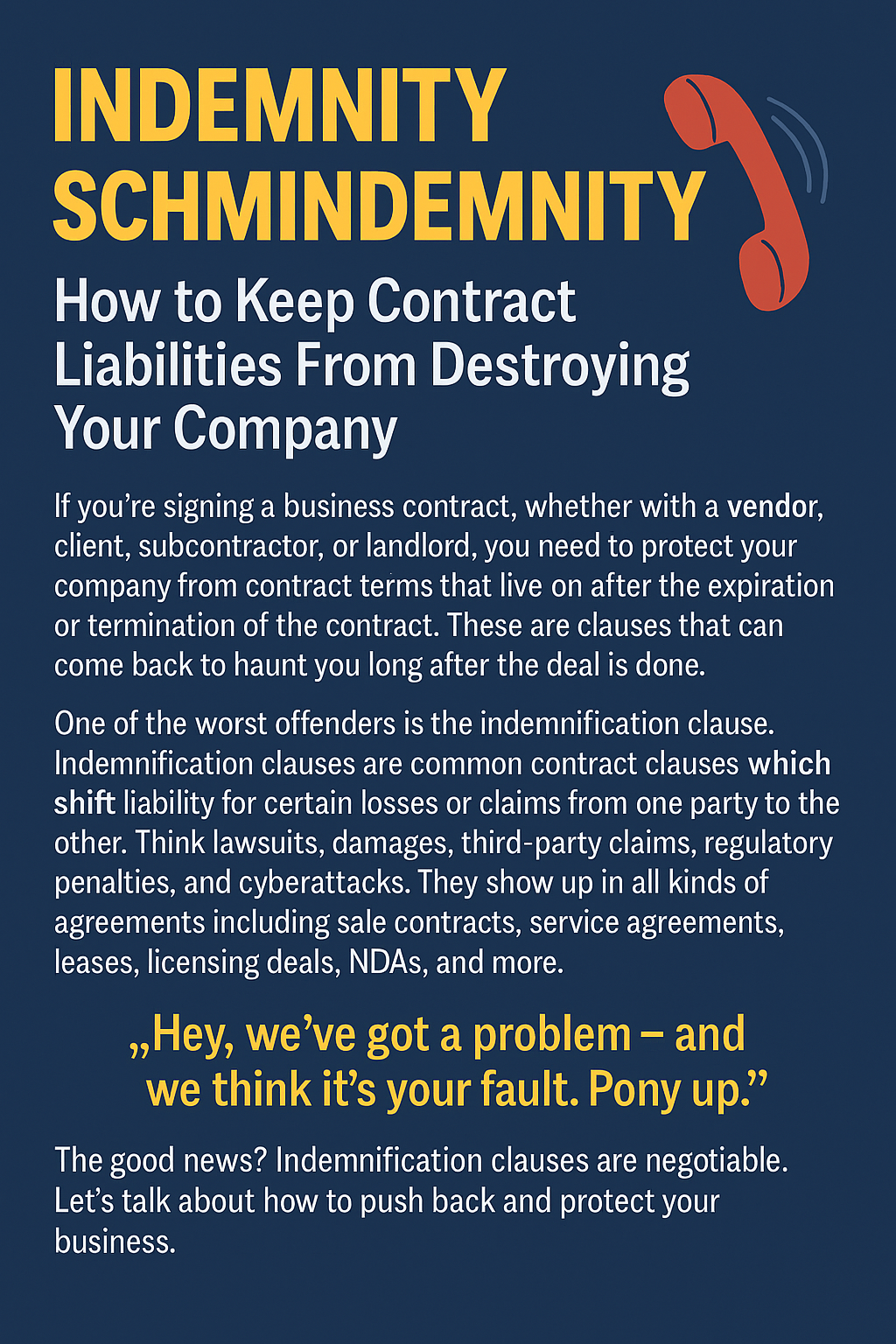Indemnity Schmindemnity: How to Keep Contract Liabilities From Destroying Your Company
"Hey You Have a Problem, and We Think It is Your Fault, Pony Up."


If you’re signing a business contract, whether with a vendor, client, subcontractor, or landlord, you need to protect your company from certain contract terms that live on after the expiration or termination of an agreement. These are clauses that can come back to haunt you long after the deal is done.
Some of the worst offenders are indemnification clauses. Indemnification clauses are common contract clauses which shift liability for certain losses or claims from one party to the other. Think lawsuits, damages, third-party claims, regulatory penalties, and cyberattacks.
They show up in all kinds of agreements including sale contracts, service agreements, leases, licensing deals, NDAs, and more.
Indemnity language is like your long-forgotten contract calling you up months or even years later saying,
“Hey, we’ve got a problem - and we think it’s your fault. Pony up.”
The good news? Indemnification clauses are negotiable. Let’s talk about how to push back and protect your business.
1. Cap Your Exposure: The Indemnity “Ceiling”
Common Problem: The contract doesn’t cap your indemnity liability, or the cap is absurdly high.
What to Do: Limit your total exposure to a fixed dollar amount, or to the value of the contract. For example:
“Indemnity liability shall not exceed the total fees paid under this agreement.”
Still a meaningful amount, but it beats writing a blank check.
Footnote: Expect an exception for fraud or intentional misconduct - most contracts will carve that out.
2. Time Is Money: Set a Reasonable Survival Period
Common Problem: The indemnity clause lasts forever.
What to Do: Push for a 12 to 24-month survival period starting from the contract’s termination or completion. That’s usually enough time for any real issues to surface.
Contracts shouldn’t have open-ended tail risk hanging over your head indefinitely.
3. Use a Basket (And Maybe a Tipping One)
Common Problem: You're exposed to a stream of nuisance claims, $500 here, $1,200 there.
What to Do: Add a basket, i.e., a claims threshold. Indemnity doesn’t kick in unless the other party has incurred, say, $20,000 in aggregate losses.
There are two types:
- Deductible basket: You pay only the amount above the threshold.
- Tipping basket: Once the threshold is crossed, you pay the full amount.
Use whichever fits your risk tolerance.
4. Offset Rights: Give with One Hand, Take with the Other
Common Problem: You’re still owed money under the contract (fees, bonuses, milestone payments), but now the other side wants to claim indemnity and delay or deduct.
What to Do: Negotiate offset rights, i.e., allow any indemnity claims to be applied against what they still owe you, not what you’ve already been paid.
It protects your cash flow and avoids the need to cut a check.
5. Say No to Sandbagging
Common Problem: The other party finds a problem before signing and closes the deal anyway, then sues you for it later.
What to Do: Include limiting clause:
“No indemnification claim may be made for matters known by the indemnified party prior to execution of the agreement.”
If they saw the issue and proceeded anyway, they’ve waived the right to complain.
6. Be Precise About What Triggers Indemnity
Common Problem: Vague language like “any harm or damage arising from the contract.”
What to Do: Nail down the trigger. Limit it to:
“actual losses suffered and incurred as a result of a breach.”
Avoid speculative language or “diminution in value” terms - they invite inflated damage claims.
7. Don’t Indemnify the Whole World
Common Problem: You’re being asked to indemnify everyone - subsidiaries, affiliates, employees, insurers, successors, and t third-party contractors.
What to Do: Keep it tight. Agree only to indemnify the party you’re contracting with, not an extended legal family tree.
Like: “Party A shall indemnify, defend, and hold harmless Party B.”
Enough said.
Final Word: Limit Your Risk, Protect Your Peace of Mind
Don’t assume indemnity language is just “legal boilerplate.” It’s not. These clauses are enforceable, and they can drag you and your business into costly disputes, years after the contract is finalized.
The solution? Know what’s fair, what’s standard, and what’s negotiable. And never sign until you’ve had your attorney review it.
Remember: There’s nothing boilerplate about putting your company on the hook for someone else’s mistake.
Want to review an upcoming contract or renegotiate one already in place? I’ve spent 25+ years helping businesses push back on bad terms and protect their downside. Let’s talk.
Disclaimer: This blog is for educational and informational purposes only. It is not legal advice. Portions of this blog were generated using AI.
7301 Mission Rd 244 M
Prairie Village, KS 66208
All Rights Reserved | Ralph F. Munyan Attorney At Law, LLC










